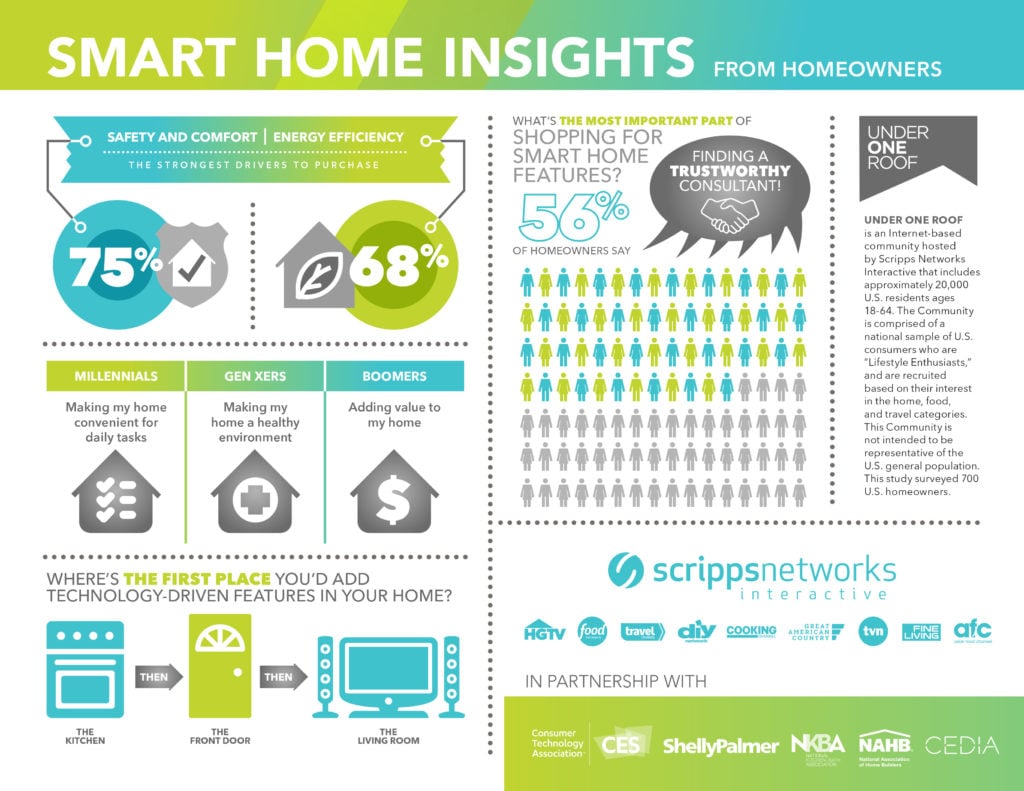The venture capitalist Marc Andreessen once said that software is eating the world. You don’t have to look very far to see that in action. The ubiquity of smartphones and social networking apps, for example, has transformed how people keep in touch with family and friends. Amazon and other e-commerce sites have revolutionized shopping. Even in health care, digital technology has already started changing how consumers choose service providers.
The pace of change today is the slowest it’ll ever be. As a business executive, you need to keep your pulse on emerging trends to avoid disappointing customers and falling behind competitors.
If you’re wondering which tech trends are quickly becoming a reality, here are four technologies that are already shaping consumer behavior—and what they mean for your business.
1. Smart devices offer consumers convenience and peace of mind
Connected devices stole the show at the 2017 Consumer Electronics Show (CES). From smart fridges to voice-activated trash cans, companies showed off futuristic gadgets that promise to make smart homes a reality.
The connected device market is ready to take off, but how can companies stand out? According to Carley Knobloch, technical consultant at HGTV Smart Home, companies should focus on customer needs.
“Consumers are voting again and again [through their purchases] for devices that offer peace of mind and anticipate their needs,” Knobloch explains to MediaVillage.
A recent study from Scripps Networks Interactive provides some clues on what consumers may be looking for and who the early adopters are. The research was conducted in the company’s insight community, Scripps Under One Roof, and found that safety and energy efficiency are two strong motivations behind smart home device purchases. For example, 75 percent of consumers said they bought a smart device to help keep their family safe and comfortable. Millennials, according to the study, are more likely to adopt smart home technology compared to Gen Xers and Boomers.

Photo credit: https://www.mediavillage.com/article/new-scripps-study-reveals-smart-living-starts-with-the-smart-kitchen/
When it comes to connected devices, “thoughtful is the new smart," says Knobloch. To launch hit products in this lucrative market, companies need to use consumer insight and inform their product roadmaps with feedback from customers.
2. Wearables shape consumer lifestyle—and save businesses money
Most wearable gadgets allow consumers to track their own health data, including activities and diet. For many consumers, wearable tech is the first step to eating better, reducing stress, and adopting a healthier lifestyle.
Despite a sluggish start, the wearable market is still growing. Experts believe this space will reach $25 billion by 2019, with smartwatches like the Apple Watch taking 60 percent of the market value.
The growth of the wearable market impacts businesses, even those outside of tech. For instance, Reenita Das, SVP of health care and life sciences at the research firm Frost & Sullivan, predicts that more companies will provide wearables to employees in an effort to reduce insurance premiums. Some companies use data from wearables to motivate employees and give incentives for attaining health goals. Das explains, “wellbeing programs will become a central, critical business imperative, necessary for optimizing not just the productivity and performance of employees, but also for managing the bottom line.”
3. Fulfillment solutions drive seamless customer experience
Digital transformation has pushed e-commerce and mobile shopping into the mainstream. Now that digital shopping is the norm, companies need to optimize the supply chain to deliver a superior shopper experience.
According to the Future of Retail 2016, an annual study from the PR firm Walker Sands, consumer expectations for seamless shipping, delivery and returns have increased in the past three years. An overwhelming majority of consumers now expect companies to offer free and one-day shopping. Free returns and exchanges, as well as easier online returns, are also significant drivers of e-commerce growth.
Dave Parro, partner and vice president at Walker Sands, says retailers must now improve the end-to-end customer experience. “The priority for retailers no longer lies in increasing the number of consumers who shop online, but rather improving their experience—whether it be online, in store or across different product categories,” he said in a statement.
"The priority for retailers no longer lies in increasing the number of consumers who shop online, but rather improving their experience."
To gain competitive edge, many smart retailers are investing in supply-chain technologies. According to Luxury Daily, 29 percent of capital expenditures in retail now go to fulfillment solutions, which include transportation, logistics and order and returns management.
Walker Sands’ study reminds retailers that they should consistently focus on the omnichannel retail experience. More than ever, companies need to understand the entire buying journey, including what happens after the purchase. Removing friction in all steps of the customer lifecycle is a must.
4. Ad blockers allow consumers to avoid unwanted ads
Ad blockers, software that lets tech-savvy consumers filter online and mobile ads, pose a big challenge for the media industry. The Interactive Advertising Bureau found that 26 percent of desktop users already use ad blockers. Another study, from the media consulting firm Midia Research, found that 80 percent of consumers who are aware of ad blocking software have used it.
The good news for media organizations is that the use of desktop ad blockers has slowed down, according to a study released early this year. In some demographics, the adoption of ad blockers even declined slightly. While the panic over ad blockers has somewhat subsided in 2017, publishers and advertisers aren’t necessarily in the clear. After all, the lucrative Millennials are more likely to use ad blockers than any other generation. Also, many consumers have indicated a need for ad blockers for mobile software.
Unless ads become more interactive, engaging and clever than ever, people will eventually tune out marketing messages one way or another. More than ever, companies need to get closer to their target audience in order to optimize their ad content as well as the channels they use.
Conclusion
As the examples above show, technology is a powerful tool in influencing and changing consumer behavior. As new technologies emerge to disrupt industries, companies of all sizes can’t afford to sit on the side lines. In a world where new technologies pop up all the time, the companies that put consumer needs first are in a position to win.









